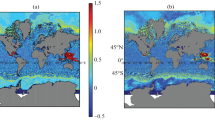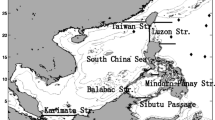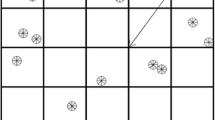Abstract
Inspired by the pioneering work of Christian Le Provost on finite element ocean modeling, a new ocean circulation model was developed over the last few years. It applies a surface triangulation and finite elements for an accurate description of coasts and bathymetry and their steering effect on the ocean circulation. A novel feature is the mesh design, which allows a vertical structure in geopotential (z) coordinates without loss of flexibility and avoids pressure gradient errors everywhere except for the lowest layer of abyssal ocean. The model is combined with sea-level measurements and data assimilation, another major research topic of Christian Le Provost. We apply the SEIK filter that was developed in Grenoble while Christian was teaching there. The addition of a local analysis scheme improves the filter performance, first of all, in its variance estimates and also in its mean solution.
Similar content being viewed by others
References
Brusdal K, Brankart JM, Halberstadt G, Evensen G, Brasseur P, van Leeuwen PJ, Dombrowsky E, Verron J (2003) A demonstration of ensemble based assimilation methods with a layered OGCM from the perspective of operational ocean forecasting systems. J Mar Syst 40–41:253–289
Danilov S, Kivman G, Schröter J (2004) A finite-element ocean model: principles and evaluation. Ocean Model 6:125–150
Danilov S, Kivman G, Schröter J (2005) Evaluation of an eddy-permitting finite-element ocean model in the North Atlantic. Ocean Model 10:35–49
Evensen G (1994) Sequential data assimilation with a nonlinear quasi-geostrophic model using Monte Carlo methods to forecast error statistics. J Geophys Res 99(C5):10143–10162
Evensen G (2003) The ensemble Kalman filter: theoretical formulation and practical implementation. Ocean Dynamics 53:343–367
Evensen G (2004) Sampling strategies and square root analysis schemes for the EnKF. Ocean Dynamics 54:539–560
Gill AE (1982) Atmosphere–ocean Dynamics. Academic, New York
Hamill TM, Whitaker JS, Snyder C (2001) Distance-dependent filtering of background error covariance estimates in an ensemble Kalman filter. Mon Weather Rev 129:1790–2776
Houtekamer PL, Mitchell HL (1998) Data assimilation using an ensemble Kalman filter technique. Mon Weather Rev 126:796–811
Houtekamer PL, Mitchell HL (2001) A sequential ensemble Kalman filter for atmospheric data assimilation. Mon Weather Rev 129:123–137
Iskandarani M, Haidvogel DB, Levin JC (2003) A three-dimensional spectral element method for the solution of the hydrostatic primitive equations. J Comput Phys 186:397–425
Keppenne CL, Rienecker MM (2002) Initial testing of a massively parallel ensemble Kalman filter with the poseidon isopycnal ocean circulation model. Mon Weather Rev 130:2951–2965
Keppenne CL, Rienecker MM, Kurkowski NP, Adamec DA (2005) Ensemble Kalman filter assimilation of temperature and altimeter data with bias correction and application to seasonal prediction. Nonlinear Process Geophys 12:491–503
Levitus S, Boyer T (1994) World ocean atlas. In: Temperature, vol 4. NOAA, Washington, District of Columbia
Levitus S, Burgett R, Boyer T (1994) World ocean atlas. In: Salinity, vol 3. NOAA, Washington, District of Columbia
Mitchell HL, Houtekamer PL, Pellerin G (2002) Ensemble size, balance, and model-error representation in an ensemble Kalman filter. Mon Weather Rev 130:2791–2808
Nerger L, Hiller W, Schröter J (2005a) A comparison of error subspace Kalman filters. Tellus 57A:715–735
Nerger L, Hiller W, Schröter J (2005b) PDAF—the parallel data assimilation framework: experiences with Kalman filtering. In: Zwieflhofer W, Mozdzynski G (eds) Use of high performance computing in meteorology. Proceedings of the 11th ECMWF Workshop, World Scientific, pp 63–83
Nerger L, Danilov S, Kivman G, Hiller W, Schröter J (2006) Data assimilation with the ensemble Kalman filter and the SEIK filter applied to a finite element model of the North Atlantic. J Mar Syst (in press)
Ott E, Hunt B, Szunyogh I, Zimin AV, Kostelich EJ, Corazza M, Kalnay E, Patil DJ, Yorke JA (2004) A local ensemble Kalman filter for atmospheric data asimilation. Tellus 56A:415–428
Pain CC, Piggot MD, Goddard AJH, Fang F, Gorman GJ, Marshall DP, Eaton MD, Power PW, Oliveira CRED (2005) Three-dimensional unstructured mesh ocean modelling. Ocean Model 10:5–33
Penduff T, Brasseur P, Testut CE, Barnier B, Verron J (2002) A four-year eddy-permitting assimilation of sea-surface temperature and altimetric data in the South Atlantic Ocean. J Mar Res 60:805–833
Pham DT (2001) Stochastic methods for sequential data assimilation in strongly nonlinear systems. Mon Weather Rev 129:1194–1207
Pham DT, Verron J, Gourdeau L (1998a) Singular evolutive Kalman filters for data assimilation in oceanography. C R Acad Sci Ser II 326(4):255–260
Pham DT, Verron J, Roubaud MC (1998b) A singular evolutive extended Kalman filter for data assimilation in oceanography. J Mar Syst 16:323–340
Tippett MK, Anderson JL, Bishop CH, Hamill TM, Whitaker JS (2003) Ensemble square root filters. Mon Wea Rev 131:1485–1490
Author information
Authors and Affiliations
Corresponding author
Additional information
Responsible editor: Jacques Verron
Rights and permissions
About this article
Cite this article
Nerger, L., Danilov, S., Hiller, W. et al. Using sea-level data to constrain a finite-element primitive-equation ocean model with a local SEIK filter. Ocean Dynamics 56, 634–649 (2006). https://doi.org/10.1007/s10236-006-0083-0
Received:
Accepted:
Published:
Issue Date:
DOI: https://doi.org/10.1007/s10236-006-0083-0




